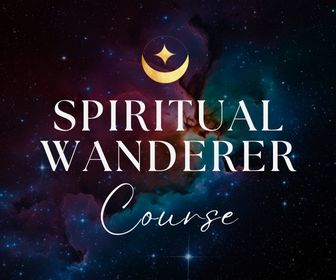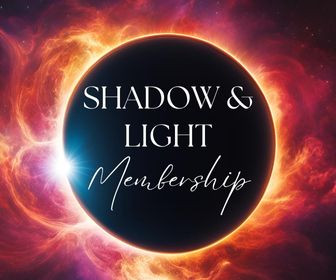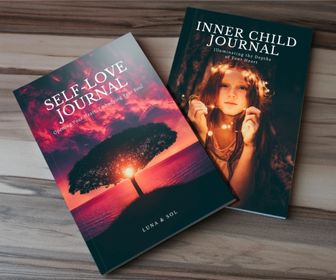How do you cope when shit hits the fan?
Anxiety is a reality we all need to deal with sooner or later. And how you support yourself through it makes all the difference in the world.
If you struggle to calm down, suffer from unresolved trauma, or have a highly charged and wound-up nervous system this article will give you a few helpful ideas for learning how to self-soothe.

Spiritual Wanderer Course:
Find your deepest path and purpose in life as a spiritual wanderer. In this immersive course, you get 3+ hours of content, workbooks, meditations, a premium test, and more!
Please note: issues such as PTSD are complex psychological matters that can’t be solved simply by self-soothing. Self-soothing is a complementary technique that you can use to ‘keep yourself together’ but it won’t get to the root of the issue. Please research the term ‘somatic experiencing’ or ‘EMDR’ if you would like to get to the root of releasing trauma.
Table of contents
What is Self-Soothing?
Self-soothing is an emotional, physical, psychological, and biological developmental task every child must learn to develop growing up. Put simply, self-soothing is the ability to calm ourselves down after experiencing something stressful.
There’s a lot of controversy surrounding when the appropriate time for a child to self-soothe happens – but ultimately, at some point during our early pre-teen years, self-soothing needs to occur.
Who is Responsible For Teaching Us How to Self-Soothe?
There are differing opinions. Some childhood experts and parents believe that self-soothing needs to happen as a baby (e.g. the infant learns to calm themselves down in their cot). Other experts and parents believe that self-soothing is impossible for a baby to develop and must instead be modeled by the parents.
In any case, if you experienced early childhood trauma, neglectful or emotionally absent parents, a chronically mentally or emotionally abusive environment, or an overall dysfunctional family, you may have been prevented from learning how to self-soothe.
12 Signs You Need to Learn Self-Soothing

Here are some signs to look out for:
- You tend to worry about everything
- You live a rushed and frantic life
- You struggle to slow down
- You have panic attacks
- Anxiety follows you throughout the day
- You tend to overthink everything
- You get stuck in repetitive cycles of thought
- You suffer from some form of trauma
- The world overwhelms you
- You approach new situations out of a place of fear rather than curiosity
- You feel unloved or unsupported by others
- You feel disconnected from your inner self
Of course, I want to mention here that self-soothing isn’t a panacea and won’t solve all of the symptoms noted above. BUT I can guarantee that if you make self-soothing a regular practice you will experience some kind of benefit.

Shadow & Light Membership:
⭐️⭐️⭐️⭐️⭐ "Receiving these messages is a beacon of light and hope for me in currently very challenging times. The words of wisdom speak right to my soul, guiding and encouraging me further on my path. I highly recommend Shadow & Light to everyone who seeks to develop and cultivate a relationship with the Inner Self." – Karin
The Benefits of Self-Soothing
Everyone is different, but here are some benefits you may experience:
- Greater ability to ‘hold yourself together’
- Feeling more supported and upheld
- More groundedness
- Deeper connection with your inner self
- Enhanced self-love and concern
- Increased ability to be mindful
- Ability to pause and see the bigger picture
- Getting out of your mind and into your body/senses
- More connection with your true feelings and perspectives
- Reduced physical ailments and illnesses
- And of course …
- Less stress and anxiety!
Don’t take this list as being written-in-stone – you may very well find a surprising benefit that hasn’t been listed above because you experience the world uniquely!
7 Self-Soothing Practices For Beginners

I’m not going to list any fancy visualization or meditation techniques here, don’t worry. Self-soothing needs to come naturally, so I strongly encourage you to seek out what works for you. You are more than welcome to build off the list of suggestions I will explore below.
A word of warning: there are healthy and unhealthy forms of self-soothing.
Not everything that ‘feels good’ when it comes to self-soothing is actually good for you.
Don’t use the excuse of trying to relax as a way of justifying toxic behaviors or habits that may harm your mind or body. Examples of negative forms of self-soothing include food binging, alcohol use, drug use, gambling, TV show binging, excessive shopping – you get the picture!
Here are some healthy and gentle self-soothing techniques that anyone who struggles with anxiety, PTSD or overly-sensitized nervous systems can use:
1. Self-holding
Okay, the term ‘self-holding’ may sound fancy – but it actually means giving yourself one big bear hug! Self-holding is a practice advocated by Peter Levine (the creator of somatic experiencing) with the intention of anchoring and calming the nervous system. It has been proven that hugs are good for you as they release the feel-good hormone oxytocin – and self-hugs are just as effective! So when you are feeling stressed or like you’re on the verge of having a meltdown, go somewhere quiet. Sit down. Hug yourself. Really focus on what it’s like to be hugged and held and let the feelings sink in.
2. Gentle hand technique
When you are feeling stressed, triggered or overwhelmed, close your eyes and focus on your body. In which area of your body do you feel the fear most strongly? Rest a gentle hand over that part of your body – like a mother would over her child. The gentle hand technique is essentially a self-parenting technique that works well alongside inner child work (but that’s a whole other can of worms). Wait a few seconds or so and focus on the hand gently rested over your fear. You may find your fear and anxiety gently decreasing after a minute or so.
3. Cross your arms, rock, deep breathing
Those who experience anxiety or PTSD may feel fractured, chaotic, split, scattered, broken or blown apart. In this state, it can be hard to define your ‘edges’ and stay in your body. When triggered by something that intensely activates the nervous system, you can use this technique. Crossing your arms helps to give you a sense of being contained and rocking mimics the feeling of being a fetus nestled in the womb (or if that feels weird, in a loving parent’s arms instead). Pair this with slow and deep breathing and you have a powerful form of self-soothing.
Would you like to save this?
Your information will never be shared.
4. Get your body moving!
When any form of anxiety or stress occurs, a tremendous amount of energy is generated in the body as it prepares to fight or flight. In order to expel some of that excess energy, get your body moving. Try jumping up and down, going for a long walk outside, or jogging in the spot (or around the block). You may also like to expel your breath using a technique such as the ujjayi yoga breath.
5. Invest in a weighted blanket
This self-soothing technique can be a bit pricey, but it’s worth it in my opinion. If you struggle with poor sleep (which often accompanies anxiety and PTSD), consider investing in your own weighted blanket.
Weighted blankets work on the basis of applying deep touch pressure stimulation (DTPS) evenly across your body which releases happy chemicals in your brain that are responsible for relaxation.
The weighted blanket I own is from an Australian company (because I live in Australia) called Neptune Blankets and I use them for sleep. You can choose the right blanket based on your body weight – generally, the best blanket for you is based on 10% of your body weight. There are other brands out there which you can find. Two great brands are:
- Quility weighted blankets (found on Amazon)
- YnM weighted adult blankets (found on Amazon)
Another interesting self-soothing tool is the deep pressure vest. Deep pressure vests are used by those who have sensory processing disorder or autism – but they can also be used by those who struggle with anxiety. Basically, a deep pressure vest is a vest you put on that tightly compresses your body – similar to a hug. If you would like a lighter option, you can always opt to try out a compression vest used by athletes, such as this one for women (which is marketed as a ‘trainer corset’) or this one for men.
6. Tulsi (Holy Basil) Tea
OMG folks, omg. I don’t usually use abbreviations like these in my articles, but this stuff is amazing. When my nerves are writhing with anxiety, holy basil is my go-to herb for calming down. Holy basil is an adaptogenic herb meaning that it helps the body adapt to stress. Holy basil is referred to as “holy” for a reason – in India, it is considered the “Queen of Herbs” due to its spiritual and restorative properties. Holy basil can also be used for adrenal fatigue, depression, high blood pressure, insomnia, and headaches. You can get some high-quality holy basil here.
Of course, you might be different and prefer other herbs such as damiana or chamomile. But having tried many relaxing herbs, holy basil is always #1 for me. If you haven’t tried this amazing herb yet, please do! You can order from Amazon or go to your local health food store and they will probably stock some.
7. Self-massage
Of all the self-soothing practices listed in this article, the one I enjoy (and do) the most is self-massage.
When we are stressed our muscles tend to contract as it’s the body’s way of entering the fight or flight mode. But what happens when anxiety and fear form the backdrop of your life? The answer is that muscle contraction starts evolving into deep-seated muscle tension and knots which need to be massaged out.
Massage helps to loosen your muscles, improve blood circulation, detoxify the body, and revitalize your energy. Like hugs, massage involves pressured touch which stimulates happy-hormones in your brain like dopamine and serotonin.
You don’t need much for self-massage – only really your hands. But I do recommend getting some kind of tool as it will make the experience much more enjoyable. I have three different massage tools which I will link to below and describe what they are for:
- A Gua Sha Chinese massager for kneading out the knots that form in my neck sometimes due to stress (this Gua Sha Massager is the exact one I use)
- A massage ball for deep-muscle massage throughout my entire body (I heat up the ball and lean against a wall with it) – this is the exact one I use
- An electric massager for easy neck and shoulder massage at the end of the day (this is the one I use)
I’m not necessarily saying that you need all of these tools – this is just what works for me. But if I was to recommend my favorite, it would be the massage ball. That little heatable ball has helped me get through some intensely chaotic and stressful periods in life. If you would like to try it out, simply put on some calming music, heat your ball, and sit against a wall with it nestled into your back. Close your eyes and breathe deeply. You can also try deep-tissue massage with a tennis ball. However, I like how it’s possible to heat the ball and enjoy the nibs which help separate muscle tissue.
If you are traveling or at work, you can always pop a small massage tool (like the Gua Sha Chinese massager) in your bag or purse. Alternatively, you can learn self-massage techniques that only involve your hands – many of which can be found simply by doing a basic google search.
***
It’s important to be realistic when using these self-soothing practices. They aren’t necessarily going to obliterate your fear from existence or immediately wipe the slate of your mind clean. Instead, the purpose of them is to help you gently and lovingly be present with your fear and support yourself through it so that you feel better. Escaping fear isn’t the answer (it only causes it to build in the unconscious) – mindfully experiencing it in a self-caring way is.

Inner Work Journal Bundle:
⭐️⭐️⭐️⭐️⭐ "I’ve just begun, and I can tell this is an investment that will make an impression on and for the rest of my life. Utilizing these workbooks is like my best friend (ME!) right there by my side, holding my hand. Highly recommend!!!" – Monica
I hope something you’ve read in this article has rung a bell or opened a new door.
If you have any self-soothing practices to recommend, by all means, share them below! You never know who might benefit.
Please note that this article has affiliate links. If you decide to purchase anything we link to, we get a small percentage to help with our work at no extra cost to you. Thanks!
Three paths to inner transformation – here’s how I can help you go deeper:
1. The Spiritual Wanderer Course: Are you feeling lost, adrift, and unsure of your life's purpose? Gain clarity, focus, and direction on your inner path by uncovering the five archetypes of awakening within you. Learn how to navigate the highs and lows of your inner journey and chart your unique path with 3+ hours of audio-visual content, workbooks, meditations, and a premium test.
2. Shadow & Light Membership: Do you crave consistent support on your spiritual quest? Receive weekly intuitive guidance and learn to embrace your whole self, including your shadow side. Cultivate deeper self-love with our affordable, personalized support.
3. Spiritual Awakening Bundle: Ready to embark on a profound soul-searching adventure? Dive into our collection of essential transformative resources! Explore five illuminating eBooks and seven in-depth journals, plus unlock two special bonuses to empower your spiritual growth.







Very helpful I have to do somatic experiencing, try emdr and talk to my inner child. Thank you!
Blessings to both of you.
My deepest gratitude for all those self-soothing ways to incorporate when needed.
Reading through, self-massage is such a profound way to self-soothe.
My daily ritual is a foot self-massage; just after my shower, before going to sleep.
It helps to re-centre, ground and root to the inner space.
So, at any moment you feel that you could be losing ground or anxious -wash your feet, sit down and self-massage your feet for some time.
Feel the connection between your hands and feet. Hands are natural healers – so think them so and get the healing from them. You’ll tell me.
Another way to calm down anxiety or overwhelming sensations/feelings or thoughts is essential oils. Find one or two that you love (whatever brings love from your inner, will always bring you that sense of calmness, groundedness and peace). Smell 2-3 times (or as much as you wish) to get back to your LOVE centre. Feel the peace, the calm and the unconditional love you need from your favourite essential oil. It works as well with a flower if it’s in proximity when needed.
I use them all – not only as self-soothing but also as a gratitude practice.
Wishing that these could be useful in times of need.
Pure Love Light
Spiritually Colourful
Danielle
Dear Aletheia, your website is one of my absolute favorites.. when it comes to wise advise , and I regularily share your articles with as many people I can think of.
I have written to you before, but just to remind you: I am that 82 year old Daniosh-born woman therapist living in the Sinai Desert in Egpt.
One of MY self-soothing techniques which I use for myself and people in need, is THE HAVENING TECHNIQUE.
Developed by dr. Ronald Ruden
See more: www. Havening.org
And www. Changeyourmindforgood.com
On youtube.com Tam Johnston NLP therapist and coach has a good explanation:
“What is havening and how does it work.”
I hope this is useful for you and Sol.
In any case, I send you kindest thoughts
And blessings on your path.
Tjalle
Right now I can sooth myself when I sit in my tight chair and l put my arms and elbows tightly to my sides
And the pressure between my arms and the chair arms starts the soothing.
This is a terrific idea (I haven’t heard many mention it before)! Thank you for sharing this here Lonnie.
Thanks for this. I love this site. So much information that’s so real and so authentic. I love it. So darn much. Thank you Sol and Luna.❤
What I do sometimes to self soothe is to drink some tea or smell some tea (flower/fruits etc) to soothe myself and sometimes I use the tapping technique on my body too! Other time I just hug myself and gently rub my body to let myself know that I’m still here for them regardless of others :)
Tapping is another fantastic practice, thank you for mentioning it + for your gratitude Yanling! ♡
Thank you for this list! I recently got this mat and it is helpful in stimulating the parasympathetic nervous system. I just wanted to pass it on as it is very relaxing and to many other people, when you read the reviews. I think I will be getting the heavy blanket from Amazon, I just worry if you do not get to warm under such a blanket. Thanks, Melina
Oops I forgot the name of the mat. It is the aasana acupressure mat at aasana.com.
Thank you for sharing this Melina!
This is a lovely article. I have started psychotherapy recently as my anxiety disorder has reared its ugly head again. Can you tell me more about the tea and whether I would be able to drink it when on medication?
I always look to others to soothe me or tell me things are going to be okay and now I know there is no quick fix to my anxiety it makes it even worse.
Thankyou for sharing about the Neptune Weighted Blankets Aletheia. I felt anxious about spending the money in case it didn’t work, but I ordered their Solace Blanket. I was really amazed how comforting it is to lay under it and experience a feeling of comfort and solace and desire to linger and embrace the experience. So I am grateful that you shared this as I had not come across it before.
Kim, I’m so happy you have relished the experience with your weighted blanket. I sleep with one every night and it was a worthy investment. :) <3 Wishing you well
WHAT IS PTSD
PTSD is Post-traumatic stress disorder. basically, it’s a type of anxiety caused by a traumatic event, that you can let go, and it may reappear in your day-by-day, like as if everything makes you come back to that situation. for example, many soldiers, when they come back of war, sadly, it’s common for them to suffer from PTSD,
im sorry if the explanation wasn’t that good, I’m not a professional. hope it helped :)
Mid-flashback EFT tapping… “I release and let it go…it’s safe to let it go”. Faster EFT website has a free course plus hundreds of videos with lectures and demos on the site and YouTube. Also at SpartanLifeCoach.com (Richard Grannon) sign up for free “Stop Emotional Flashbacks” course. Good stuff. Also available from Amazon.